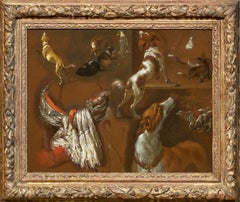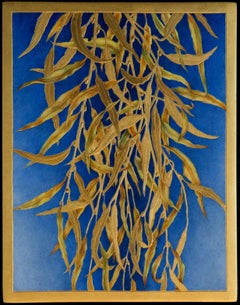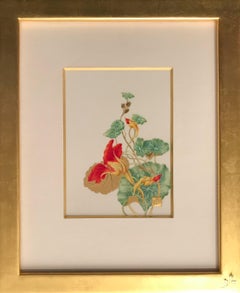Oak Still-life Paintings
to
2
1
3
3
1
2
Overall Height
to
Overall Width
to
2
1
2
1
1
1
1
1
1
1
1
1
1
1
1
2
1
35,674
12,793
9,751
5,986
5,520
Medium: Oak
"Delight or Disgust" Jell-o motif, images of food, glassware
Located in Philadelphia, PA
This piece titled "Delight or Disgust" is an original artwork by Angela Rio and is made of acrylic on masonite, framed in artist-made oak wood. This piece measures 18”h x 24”w framed...
Category
21st Century and Contemporary Contemporary Oak Still-life Paintings
Materials
Masonite, Acrylic, Oak
Ten dog studies and a study of a stole, a panel attributed to Jan Weenix
By Jan Weenix
Located in PARIS, FR
This painting is typical of the art of Jan Weenix, one of the best still life and hunting painters of the Dutch Golden Age. In a cleverly disordered manner, he depicts ten studies of dogs (mainly spaniels and greyhounds) and the sumptuous study of a stole. These studies were probably intended to be used as a source of inspiration and adapted in the painter's compositions, as we will see in a close examination of some of his paintings.
1. Jan Weenix, a prolific still life painter
Jan Weenix was born into a family of artists: his father Jan Baptist Weenix (1621 - 1659) was also a landscape and still life painter and his mother Josyntgen d'Hondecoeter was the daughter of the animal painter Gillis d'Hondecoeter (1575 - 1638). His father trained him together with his cousin Melchior d'Hondecoeter (1636 - 1695).
In 1664 Jan Weenix became a member of the St. Luke's Guild in Utrecht, to which he belonged until 1668. In 1679 he married Pieternella Backer with whom he had 13 children. His compositions, often related to hunting (still lifes, portraits of hunters) were very successful, ensuring him a certain financial ease. Jan Weenix also painted large-scale decorations: while staying in Düsseldorf with the Prince-Elector of the Palatinate between 1702 and 1712, he executed twelve gigantic compositions combining landscapes, hunting scenes and still life for the Bensberg hunting lodge.
2. Description of the artwork
The painting displays a great apparent disorder that hides a rigorous organisation in four quarters. It presents ten studies of hunting dogs and one study of a stole.
The studies of the stole and of two of the dogs (the greyhound in the lower right and the spaniel in the upper right quarter) are quite elaborate, whereas those of the other dogs are sketchier. As an example, the dog in the upper right corner is only partially painted. The dogs' coats, of different colours - brown, sandy, grey or black - stand out against the warm brown background and are illuminated by the shine of their white hair.
This white colour, probably executed with ceruse white, illuminates the study of a stole which stands out in the lower left-hand corner while the red colour of its lining warms up the composition.
The purpose of this stole is enigmatic: we think it is probably a neckband, but it could also be the back of the turban of an oriental character. To the right of this stole is the outline of a long animal leg, perhaps a horse leg.
Similar studies are rare in the work of Jan Weenix, but the Rijksmuseum recently acquired the study of a seated monkey. This study, executed in the same brown chromatic range, is much more accomplished. It has been reused with minimal change in many compositions. It is likely that Jan Weenix had less frequently a monkey at his disposal, and that he therefore depicted it in great details, whereas he could probably easily find dogs as models. Note the characteristic white dot in the corner of each pupil that brings them to life!
3. Related artworks
We have tried to relate the various dogs in this study to the countless dogs that appear in the paintings of Jan Weenix, as listed in the catalogue 'Father and Son - Weenix' compiled by Anke van Wagenberg- Ter Hoeven in 2018.
A first example is the painting entitled "The Prodigal Son on the Steps of a Palace" (catalogue number 7 - 8th photo in the gallery). In the lower left-hand corner of the composition, a spaniel is barking at a peacock perched on a stone. This spaniel, which is depicted in a similar manner in the "Portrait of a Young Man with a Falcon" in the Bremen Kunsthalle (catalogue number 76), is reminiscent of the spaniel in the upper left-hand quarter of our study (although the latter is slenderer and the direction of its head differs).
We also find, in a slightly different pose, the seated greyhound that is at the top of our painting in the composition representing "A Swan, a Stag, a Hare and Birds presented by two hunting Valets" (catalogue number 130 - last photo in the gallery). The sketch of this greyhound in our study is unfinished: the painter only painted the grey undercoat and the white parts of the coat, without completing the sandy coat which appears in the final painting.
We can see from these various examples that our study was probably more a repertoire of forms than a model for a specific composition. The painter probably used it for inspiration before adapting each dog study...
Category
Late 17th Century Old Masters Oak Still-life Paintings
Materials
Oak, Oil
Still Life with Herring, a panel by the workshop of Georg Flegel (1566 - 1638)
Located in PARIS, FR
Fred G. Meier, art historian, confirmed with the following comment, after a photographic examination of the work, that it belongs to the studio of Georg Flegel...
Category
1630s Old Masters Oak Still-life Paintings
Materials
Oak, Oil
Related Items
Fine Classical Still Life Summer Flowers, British Oil Painting Exhibition label
Located in Cirencester, Gloucestershire
'Summer Flowers'
by Margaret Ryder (British b. 1908)
signed oil on canvas, framed
frame: 33 x 26 inches
canvas: 27 x 20 inches
provenance: private collection, UK
Exhibited at the Roy...
Category
Mid-20th Century Old Masters Oak Still-life Paintings
Materials
Oil
No Reserve
H 33 in W 26 in D 1 in
Untitled
By Richard Pousette-Dart
Located in Miami, FL
Acrylic on masonite. This is a pivotal work in deep and radiant cobalt blue from 1950. It dipicts calligraphic and hieroglyph structures over a grid and pyramidal base by the first generation abstract expressionist.
Provenance: Skinner: November 13, 1992 [Lot 00219}, The entry in the Skinner catalog indicates that the painting came directly from the artist to the family of the consignor to Skinner. Kaminsky Auctions. There is an unbroken paper trail that traces the ownership of the painting from the current owner, through two auction houses to the artist. Perfect unbroken provenance.
Pousette-Dart was among the most inventive of the Abstract Expressionist generation, His uncanny talent was to expand the nature of abstraction and still make each mark each element very much his own; a reflection of what he called "the concealed power of the spirit," he said, “not of the brute physical form." His was not aiming for a singular, realized aesthetic formula but to expand the possibilities of painting; the transcendental in painting. Typical of such invention and exploration is this painting Untitled 1950 when the artist was only 34 years old and represented by one of the champions of the new American painting, Betty Parsons.
A banner year for Pousette-Dart, the Museum of Modern Art acquired their first painting by the Minnesota born artist. He worked on easel size works such as this painting an oil on masonite. At the same time Pousette-Dart was also working on larger scale works such as Path of the Hero, running over ten feet in length now in the collection of the Metropolitan Museum of Art. Both contain fields of color articulated by a highly sophisticated white hieroglyphic vocabulary. Rather than demonstrate an expressionist sensibility, Pousette-Dart harnesses his more cerebral ideas transforming thick areas of paint into a more refined composition of geometric forms akin to the pattern and forms of say a stained glass window. In a way he is looking back at Fugue, 1940 a black and white composition which makes use of a similar format of painting albeit smaller. Color and form are minimal, but what Pousette-Dart has maximized is the rhythmic and syncopated character of painting casting his ideas into purely symbolic terms that one might link to the pictograms of Adolph Gottlieb. Nonetheless, nature is always at the core of Pousette-Dart’s thinking and dreaming. Here he has transformed the local Ramapo Mountains—where he will eventually move with his family to live and work— into a complex series of articulated fragments linked by style, scale and color. The painting’s imagery built on two large triangles and reduced to just two colors, cobalt blue and white all outlined in black. Pousette-Dart symbols stacked in horizontal and vertical rows: blue is ground, white is language, symbolic of light, consciousness and awareness . The painting maintains a mystical character images compounded that formulate a secret code and linked to the series of white paintings Pousette-Dart authored in the first half of the 1950s. Get up close to the picture and you discover images within images a kind of picture puzzle...
Category
1950s Abstract Expressionist Oak Still-life Paintings
Materials
Masonite, Acrylic
Antique French Still Life of Flowers in Vase Signed Oil Painting on Canvas
Located in Cirencester, Gloucestershire
Classical Still Life of Flowers in a Vase
French School, circa 1900
signed oil on canvas, unframed
canvas: 22 x 18 inches
provenance: private collection, France
condition: very good ...
Category
Early 20th Century Old Masters Oak Still-life Paintings
Materials
Oil
18th century portrait of a Spaniel dog with fruit in a wooded landscape.
By Tobias Stranover
Located in Woodbury, CT
Outstanding early 18th-century portrait of a seated Spaniel dog in a landscape with an array of fruits.
Attributed to the work of Tobias Stranover.
...
Category
1730s Old Masters Oak Still-life Paintings
Materials
Oil
Free Shipping
H 24.5 in W 34.5 in
Huge 18th Century Italian Old Master Oil Painting Still Life Fruit in Basket
Located in Cirencester, Gloucestershire
Classical Still Life of Fruit in Basket with other objects
Italian artist, 18th century
oil on canvas, unframed
canvas: 24.5 x 33 inches
provenance: private collection, UK
condition:...
Category
18th Century Old Masters Oak Still-life Paintings
Materials
Oil
H 24.5 in W 33 in D 1 in
Antique French Still Life Strawberry Bowl Abundant Still Life of Fruit Interior
Located in Cirencester, Gloucestershire
Still Life of Fruit
French School, mid 19th century
indistinctly signed lower right corner
oil on canvas laid on board, framed
framed: 27 x 35 inches
board: 25 x 33 inches
provenance...
Category
Late 19th Century Old Masters Oak Still-life Paintings
Materials
Oil
Dog sat amongst Roses, original oil on canvas, Victorian British artist
Located in Nutfield, Surrey
This lovely picture of a dog sat amongst roses is an oil-on-canvas painting that is over one hundred years old, by the English Artist Stanley Berkeley...
Category
19th Century Victorian Oak Still-life Paintings
Materials
Oil, Canvas
H 21.5 in W 17.5 in D 4 in
Fine Classical Still Life Oil Painting Ornate Flowers in Vase Gilt Framed Oil
Located in Cirencester, Gloucestershire
Classical Still Life of Flowers
French School, early 20th century
oil on board, framed
framed: 12 x 8.5 inches
board: 11 x 8.5 inches
provenance: private collection, France
condition...
Category
Early 20th Century Old Masters Oak Still-life Paintings
Materials
Oil
A German Pointer with hunting Equipment
Located in Stoke, Hampshire
German School (18th century)
A German Pointer with hunting Equipment
Oil on canvas
Canvas Size 42 x 35 in
Framed Size 48 x 41 in
Category
18th Century Old Masters Oak Still-life Paintings
Materials
Oil
Large Spanish Old Master style Oil Painting Ornate Flowers in Vase
Located in Cirencester, Gloucestershire
Studio of Miguel Canals, Spanish 1925-1995
Still life painting with flowers in a vase
oil painting on canvas, framed
oil on canvas, unframed
canvas: 23 x...
Category
20th Century Old Masters Oak Still-life Paintings
Materials
Oil, Canvas
Fine Classical Still Life Flower Painting Signed & Dated English Oil
Located in Cirencester, Gloucestershire
Classical Still Life of Flowers
English artist, 20th century
signed oil on board, unframed
dated 1980
board: 14.5 x 11.5 inches
provenance: private collection, UK
condition: overall ...
Category
20th Century Old Masters Oak Still-life Paintings
Materials
Oil
"DUCK HUNT" MERGANSERS, DUCK CALL, SHOTGUNN DATED 1889 FRAME 43 X 35 NEWCOMB
Located in San Antonio, TX
Edward Chalmers Leavitt
(1842 - 1904)
Rhode Island Artist
Image Size: 36 x 28
Frame Size: 42.5 x 34.5 Newcomb Macklin Frame.
Medium: Oil
Dated 1889
"Duck Hunt" Mergansers
Edward Chalmers Leavitt (1842 - 1904)
Edward Chalmers Leavitt, artist, was born in Providence, Rhode Island, March 9, 1842, the son of Rev. Jonathan and Charlotte Esther (Stearns) Leavitt. His paternal ancestor was John Leavitt, who came to Massachusetts Bay in the first ship and settled in Hingham. On the maternal side, he is descended from John Alden and Priscilla Mullens, who came to Plymouth in the Mayflower.
Leavitt was educated in private schools in Providence, and at Kimball Union Academy, Meriden, New Hampshire. During the Civil
War in 1862 and 1863, he served in the navy on the U.S.S. Galena. In his profession of artist, Mr. Leavitt is especially noted as a painter of fruit, flowers and still life.
He exhibited in the National Academy for several years and has made many successful exhibitions in Providence and Boston. He was a member of the Boston and Providence art clubs, and the Providence Press Club. He was also a member of the Grand Army of the Republic. In politics his proclivities are mainly Republican. He has been twice married: first, May 19, 1877, to Ellen M. Fuller; and second, April 22, 1880, to Elizabeth S. Chace.
Submitted November 2004 by Edward Bentley, Art Collector and Researcher from Lansing, Michigan.
Source is the publication "Men of Progress: Biographical Sketches and Portraits of Leaders in Business and Professional Life from the State of Rhode Island." New England magazine. 1896.
Edward C. Leavitt, born in 1842, has been described as "Providence, Rhode Island's leading still-life painter" in the late 19th Century. (Zellman 324) His teacher, James Morgan Lewin, was a prominent still-life painter in Fall River, Massachusetts, a neighboring town.
Leavitt, a detailed, sharp-focused, realistic painter, was in love with texture and light, and was prolific and successful, painting a variety of still life subjects including flowers, fruit and even fish and dead game animals. His objects, including costly antiques and household decorative items, were often placed on ornamental, gleaming surfaces.
He was a frequent exhibitor at the National Academy of Design in the 1870s and 1890s. The artist, who died in 1904, moved from a position of success and popularity to being ignored for many years until the publication of William H. Gerdts and Russell Burke's American Still-Life Painting in 1971. It is uncertain whether this disastrous loss of respect took place because Leavitt's work declined in quality during the last decade of his life, or because he was a victim of the periodic shifts in taste and fashion that afflict the arts.
Sources:
Michael David Zellman, 300 Years of American Art
Peter Hastings Falk, Editor, Who Was Who in American Art
Biography from Roger King Fine Art
Edward Leavitt was one of the leading still life artists of nineteenth century New England. He lived and worked in Providence, and studied with James Morgan Lewin, a leading painter of the Fall River School, which, in the late 19th Century, was one of the most important centers of still life painting.
While Lewin branched out into other types of painting, Leavitt remained devoted to the art of the still life. His paintings are sharply focused, realistic, and carefully finished. Ornate objects such as urns, ewers, platters, cut glassware...
Category
1880s Realist Oak Still-life Paintings
Materials
Oil
Previously Available Items
Weeping willow
By Sue Viner
Located in London, GB
With a virtuoso hand, combined with an acute observation, appreciation, and understanding of nature, Sue Viner’s work marries ancient techniques and knowledge, with a contemporary se...
Category
2010s Naturalistic Oak Still-life Paintings
Materials
Gold Leaf
Nasturtium
By Sue Viner
Located in London, GB
With a virtuoso hand, combined with an acute observation, appreciation, and understanding of nature, Sue Viner’s work marries ancient techniques and knowledge, with a contemporary se...
Category
2010s Realist Oak Still-life Paintings
Materials
Gold Leaf
Oak still-life paintings for sale on 1stDibs.
Find a wide variety of authentic Oak still-life paintings available on 1stDibs. While artists have worked in this medium across a range of time periods, art made with this material during the 18th Century and Earlier is especially popular. There are many well-known artists whose body of work includes ceramic sculptures. Frequently made by artists working in the Old Masters, all of these pieces for sale are unique and many will draw the attention of guests in your home. Not every interior allows for large Oak still-life paintings, so small editions measuring 0.1 inches across are also available Prices for still-life paintings made by famous or emerging artists can differ depending on medium, time period and other attributes. On 1stDibs, the price for these items starts at $1 and tops out at $1,985,000, while the average work can sell for $2,192.
Recently Viewed
View AllMore Ways To Browse
Arcimboldo Art
Acrylic Fruit Bowl
Bouquet De Fleurs Vintage
Oil Painting Hyacinth
Claesz Heda
Falling Light In The Hunter
Leroy Neiman Boxing
Robin Cole
Willem Claesz Heda
A D Greer
French Painted Pot Board
Lauren Vase
Victor Safe
Painting Of Terracotta Pot
Rain Hockney
Hydra Greece
Richard Thomas Scott Paintings
Vitreous Enamel On Copper






